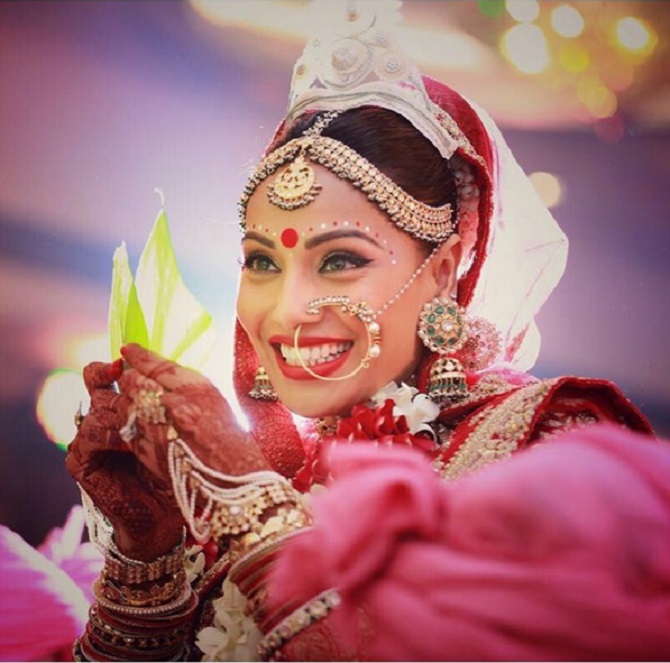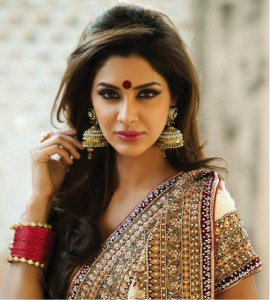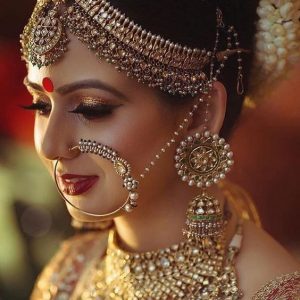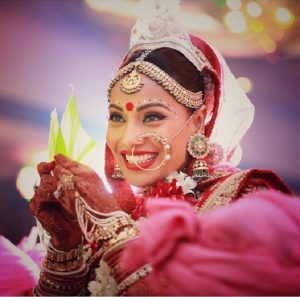
Bridal Bindi

Indian Bindi
Indian Bridal makeup is incomplete without the characteristic brow bindis which are red and white in color. These eyebrow miniature bindis complete the ritualistic bright red bindi in the center and it looks like the full moon with small stars in the ambit. One of the most characteristic features of an Indian bride’s face are these small red and white bindis, which, over the course of time, have become more ornate.
The eyebrow bindis have metamorphosed into an art and those simple red and white kum-kum bindis have given way to sticker gems of different colors and patterns. However, it is customary for Bengali brides to have the small red and white bindis, which are often painted in an ornate fashion. In fact, these miniature bindis are a part of the traditional ‘solah shringar’ of a bride and add more beauty and charm to her face.
Background

Red Bridal Bindi
Erstwhile, these bindis, including the one placed between the eyebrows, were elaborately painted on. However, modern day brides indulge in bling with gems replacing these bindis. However, a lot of brides choose to go completely traditional and ethnic with chemical free paints for making elaborate red and white designs on the forehead- albeit dotted with shimmer and gems to go with the current trend.
A lot of the more conscious brides who fear damaging their make-up go in for sticker bindis that are gem encrusted to accentuate their overall look. The bindi art is different for brides hailing from different states. For instance, a lot of North Indian brides prefer bling and usually opt for sticker gems and bindis with a large bindi forming the center. However, the Bengali brides go for the traditional red big bindi in the middle and the traditional red and white dots and embellishments that are painted on, commonly known as Chandan. On the other hand, Marathi brides don the traditional crescent-shaped bindi in the center and elaborate the look with colorful designs and dots around the eyebrows.
Significance

Bridal Bindi (SOurce: Rediff.com)
There are only a few adornments that set the bride apart from the rest and the red and white bindis are one such adornment that bring out the beauty of the bride. The Bindi is the symbol of the marital status of a woman. As per Ayurveda, the bindi also has a physiological significance as it is placed on the forehead which controls the nervous system and is an acupressure point that maintains good flow of blood. The significance of the bindi in between the eyebrow, in particular, is said to retain energy in the body and enhances concentration.
When wearing the small bindi embellishments over the eyebrow, the makeup artist must ensure that the bindi art suits the bride’s forehead type. Brides with smaller foreheads should opt for smaller-sized bindis that are widely spaced apart whereas the ones with a wider forehead region can opt for the bigger and more elaborate ones. Bling is in, but one must avoid going overboard when it comes to bridal bindi designs. If your maangtikka is ornate, then a simple and spaced-out pattern would complement it best.
The many red and white bindis adorning a bride’s forehead symbolize Goddess Parvati who brings in good fortune. Furthermore, there is a special significance of the colors white and red, wherein the former stands for peace and tranquility whereas red stands for love and matrimony. An Indian proverb that sums it all- “A woman’s beauty is multiplied a thousand times when she wears a bindi”- holds true when it comes to the traditional Indian bride.
References
Categories: Cultural Connections, Traditional Practices
